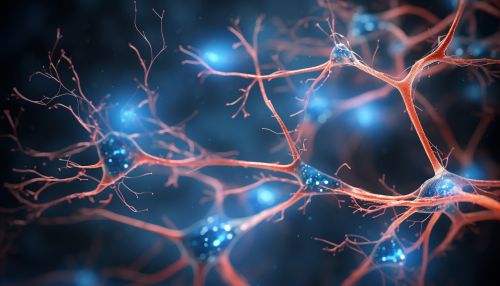Axon
Overview
An axon, also known as a nerve fiber, is a long, slender projection of a nerve cell, or neuron, that typically conducts electrical impulses known as action potentials away from the neuron's cell body. The function of the axon is to transmit information to different neurons, muscles, and glands. In certain sensory neurons, such as those for touch and warmth, the axons are called afferent nerve fibers and the electrical impulse travels along these from the periphery to the cell body, and from the cell body to the spinal cord along another branch of the same axon.


Structure
Axons are in effect the primary transmission lines of the nervous system, and as bundles they help make up nerves. Some axons can extend up to one meter or more while others stretch to as little as one millimeter. The longest axons in the human body, for example, are those of the sciatic nerve, which run from the base of the spine to the big toe of each foot. The diameter of axons is also variable. Most individual axons are microscopic in diameter (typically about one micrometer across).
Function
The primary role of the axon is to carry electrical signals, known as action potentials, from the neuron's cell body to the synapse, the junction where the axon's terminal buttons meet another neuron's dendrites. The axon carries these action potentials away from the cell body and towards other neurons, muscle cells, or glands.
Myelination
Many axons are covered by a layered myelin sheath, a fatty insulating substance that increases the speed at which electrical impulses travel along the axon. The myelin sheath is formed by oligodendrocytes in the central nervous system and Schwann cells in the peripheral nervous system.
Axonal Transport
Axons contain a system of transport for cellular components called axonal transport. This system allows for the movement of mitochondria, lipids, synaptic vesicles, proteins, and other cell parts to and from the neuron's cell body through the axon.
Pathology
Damage to an axon, or axonopathy, can cause a range of neurological disorders, including multiple sclerosis and Guillain-Barré syndrome. Axonopathies can be caused by physical trauma, inflammation, toxins, or genetic conditions.
